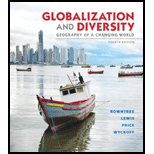
The way in which centralized planning created a new economic geography across the former Soviet Union and its lasting impact.
Answer to Problem 1RQ
The Soviet-era was marked by the dominance of centralized economic planning on industries and agriculture. The state supported heavy industries instead of consumer goods. Agriculture was on account of enormous collectives and state-managed farms. Much of the region’s infrastructure was established during this period. During the post-Soviet era, the centralized economy declined giving way to an open economy. Privatization of agriculture was done during this period, however, the basic distribution of food-stuffs continues to be little changed from the Soviet-era.
Explanation of Solution
Much of the current economic infrastructure comprising of industrial expansions, new urban centers and the modern transportation networks and communication linkages was developed during the communist era. Through a centralized economic system, the communist leaders such as Stalin consolidated power, thus nationalizing Russian agriculture and industries, through which the state managed production targets and industrial output.
The Soviets accentuated on heavy basic industries like the steel, machinery and chemical industries as well as electricity generation, instead of consumer goods. Stalin transformed the agricultural land into big collectives and state-controlled farms, by the late
In general, the postwar period brought actual economic and social enhancements for the Soviet people. In spite of the achievements, more problems arose during the
Much of the greatly centralized state-controlled economy, predominantly within Russia, has been substituted by a mixed economy of private initiative and state-run operations. The collapse of the Soviet Union also meant that economic relationships between the former Soviet republics were no longer controlled by a single, centralized government. From
Even though the agriculture got privatized, its productivity and distribution remains little altered from that of the Soviet period. Moreover, the retaining institutions have also increased, like the “informal economy” and the natural resources and heavy industrial sectors that were privatized in the beginning, were now brought under state-management. The achievements of the new economy are progressively perceptible on landscape as well, in the form of new buildings, malls and improved housing sectors. Yet, poverty remains as a crucial feature of everyday life in the rural areas.
Want to see more full solutions like this?
Chapter 9 Solutions
Globalization and Diversity + Masteringgeography With Etext Access Card
 Applications and Investigations in Earth Science ...Earth ScienceISBN:9780134746241Author:Edward J. Tarbuck, Frederick K. Lutgens, Dennis G. TasaPublisher:PEARSON
Applications and Investigations in Earth Science ...Earth ScienceISBN:9780134746241Author:Edward J. Tarbuck, Frederick K. Lutgens, Dennis G. TasaPublisher:PEARSON Exercises for Weather & Climate (9th Edition)Earth ScienceISBN:9780134041360Author:Greg CarbonePublisher:PEARSON
Exercises for Weather & Climate (9th Edition)Earth ScienceISBN:9780134041360Author:Greg CarbonePublisher:PEARSON Environmental ScienceEarth ScienceISBN:9781260153125Author:William P Cunningham Prof., Mary Ann Cunningham ProfessorPublisher:McGraw-Hill Education
Environmental ScienceEarth ScienceISBN:9781260153125Author:William P Cunningham Prof., Mary Ann Cunningham ProfessorPublisher:McGraw-Hill Education Earth Science (15th Edition)Earth ScienceISBN:9780134543536Author:Edward J. Tarbuck, Frederick K. Lutgens, Dennis G. TasaPublisher:PEARSON
Earth Science (15th Edition)Earth ScienceISBN:9780134543536Author:Edward J. Tarbuck, Frederick K. Lutgens, Dennis G. TasaPublisher:PEARSON Environmental Science (MindTap Course List)Earth ScienceISBN:9781337569613Author:G. Tyler Miller, Scott SpoolmanPublisher:Cengage Learning
Environmental Science (MindTap Course List)Earth ScienceISBN:9781337569613Author:G. Tyler Miller, Scott SpoolmanPublisher:Cengage Learning Physical GeologyEarth ScienceISBN:9781259916823Author:Plummer, Charles C., CARLSON, Diane H., Hammersley, LisaPublisher:Mcgraw-hill Education,
Physical GeologyEarth ScienceISBN:9781259916823Author:Plummer, Charles C., CARLSON, Diane H., Hammersley, LisaPublisher:Mcgraw-hill Education,





